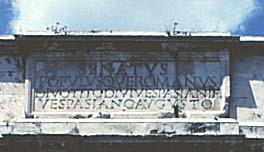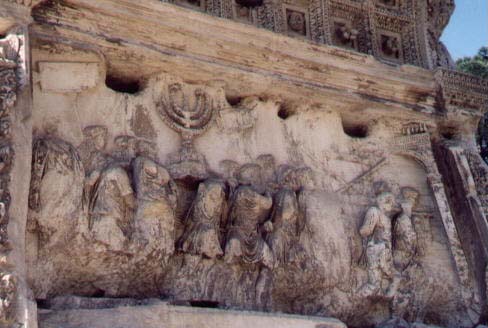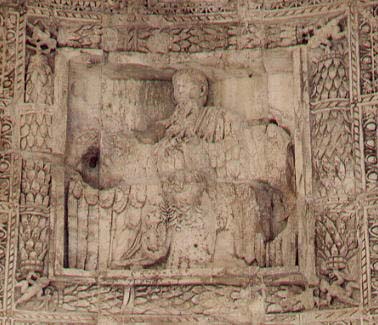|
|
 |
|
O Divine Titus! A Roman Triumph |
|
written
by zihengxu / 09.05.2004 |
|
|
| |
Description |
| |
| |

|
| http://www.bluffton.edu/~sullivanm/titus/arch.jpg |
| Arch of Titus |
|
| |
|
| |

|
| http://www.bluffton.edu/~sullivanm/titus/titus.html |
| Inscription on the Arch of Titus |
| "Senatus Populusque Romanus Divo Tito Divi Vespasiani Filio Vespasiano Augusto"
"The Roman Senate and People to Deified Titus, Vespasian Augustus, son of Deified Vespasian" |
| |
|
| |

|
|
| Titus in his Chariot |
|
| |
|
| |

|
|
| Spoils of War |
|
| |
|
| |

|
|
| Eagle Carrying Titus to Heaven |
|
| |
|
The Arch of Titus was erected in the year 82. Titus had only ruled the Empire for merely 3 years before the Gods reached out and invited him to Heaven. The arch was commissioned by his brother Domitian. Though Titus wasn't able to see this arch in his lifetime, this was but a minor setback. Through this arch, his honor would be retained through history, and his greatest accomplishment will be taught to the young.
--------------------------------
The Colloseum side of the ceiling contains this inscription: "Senatus Populusque Romanus Divo Tito Divi Vespasiani Filio Vespasiano Augusto", or, "the Roman Senate and People to Deified Titus, Vespasian Augustus, son of Deified Vespasian". The Senate and people honoured Titus by dedicating this triumphal arch to him.
The two relief panels on the side of the passageway make up the core of this arch. The first relief shows the spoils of war from the Temple of Solomon: The Menorah, the Altar, the trumpets, and the placards. What is remarkable about this relief is its depth and perspective. The spoils procession, heading towards a honourary arch, is lead by the Altar and followed by the Menorah, but the arch is much smaller in size compared to the Menorah; hence the arch must appear from a distance. The Menorah party is also considerably larger than the Altar carriers. As a result, the Menorah appears much closer to the observer, and this generates a sense of realism in the procession.
The second relief shows Titus in his quadriga, a royal chariot drawn by four horses, riding with the winged goddess of victory on his shoulders. Similar to the first relief, Titus also appears closer to the observer. Together the two reliefs complete the core of Titus' triumph procession. Furthermore, this imaginary procession faced in the actual direction of the real triumph procession, proceeding from the Colloseum to the Palatine Hills through Via Sacra.
When a traveler walks under the arch, he could look up into the vault and find the carving of Titus riding on an eagle. The sacred eagle is the messenger sent by the Gods. It would carry Titus to Heaven, where the deceased emperor shall continue to watch over the people from above.
--------------------------------
Although the arch today seems to have survived two thousand years of wear and tear, and it may appear in a great shape, it actually is not. The first major reconstruction came during the Middle Ages when the Frangipani family, then ruler of Rome, incorporated the arch into their city wall. Huge holes were punched into the wall to make places for beams. Later the wall was taken down and the arch was saved, though in quite a mess. Miraculously, the reliefs were preserved in great condition.
In the early 19th century the arch was breaking apart. The condition was so terrible that major reconstruction projects were inevitable. In fact when Giuseppe Valadier tried to repair the arch in 1822, he decided to break down the entire arch and then rebuilt it with frame support of travertine stones. Travertine stone was more durable than marble, and Valadier wanted to distinguish the repaired arch from the original marble monument.
|
| |
|
| |
|
|
 |
|





